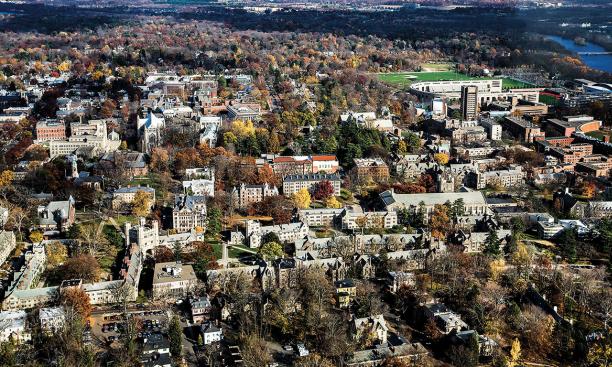
Princeton appears ready to expand again, as a “framework” adopted by the Board of Trustees in January recommends increasing the size of the undergraduate student body, accepting transfer students, and investing in programs and buildings in growing fields such as engineering, environmental studies, and computer science.
The 24-page document will serve as a guide for University decision-makers. It identifies major goals and priorities and lays out questions and standards to be used in pursuing them, and comes after two years of discussions in which University task forces have been exploring topics ranging from the future of the humanities to the residential colleges. The main objective of the blueprint is “not to specify all of the University’s future initiatives, but to create a planning framework for determining them and for understanding the trade-offs among them,” the report said.
“While the completion of this framework is a significant achievement, more planning remains ahead of us,” said President Eisgruber ’83. “The framework identifies a number of goals that will require very substantial commitments of resources and significant fundraising.”
Undergraduate Student Body
The trustees authorized the start of planning to expand the undergraduate student body by 125 students per class, adding 500 students to the present total of 5,200. To accommodate additional students, plans for a seventh residential college will be developed over the course of this year. University officials did not specify possible sites for the new college.
A larger student body would allow Princeton, through its alumni, to make a more significant contribution to the nation and world, Eisgruber has said. This would be the first expansion of the undergraduate population since 2005, when the University began adding a total of 500 students.
Continuing efforts to attract a more diverse pool of applicants, Princeton will begin planning for a transfer program, a policy that was discontinued in 1990 and could be reinstated as early as 2018. Allowing transfers could encourage a wider range of applicants, including students enrolled in community colleges and U.S. military veterans, the report said.
Engineering/Computer Science
Despite new facilities in recent years, most of the engineering school is housed in facilities that are “no longer adequate,” the report said, and Princeton will need to “invest aggressively” to support the school. The report singled out fields related to information science, noting that competition with the private sector for faculty in computer science is especially intense and that over the past decade, enrollment in computer science courses has quadrupled.
Among other recommendations, the trustees said Princeton should:
- Increase the graduate-student population “incrementally” and offer the resources to attract the best grad students.
- Develop an interdisciplinary program in environmental studies and build new facilities to house it. The report noted the urgency of global environmental issues and increasing student interest in related fields of study (see story, page 18).
- Expand study-abroad programs and the study of key regions and cultures.
- Reinforce that service and civic engagement are priorities in both academic and extracurricular realms.
- Continue Princeton’s “signature commitment” to affordability and ensure that all students can “share fully in the educational opportunities it offers.”
- Exercise “visible leadership” in the arts and humanities, especially in light of cutbacks elsewhere in these areas.
- Enhance the diversity and inclusivity of “the entire campus community at all levels and in all fields,” with a particular focus on diversifying the faculty.
The framework includes the first update to the University’s mission statement in 15 years: “Princeton University advances learning through scholarship, research, and teaching of unsurpassed quality, with an emphasis on undergraduate and doctoral education that is distinctive among the world’s great universities, and with a pervasive commitment to serve the nation and world.” In highlighting Princeton’s distinctive emphasis on undergraduate education, past mission statements have not been as clear in recognizing the role of the Graduate School.
Addressing the University’s finances, the report said that the trustees have approved changes that should give the administration more flexibility in spending from the endowment, which was valued at $22.7 billion in June 2015 and which supports nearly half of Princeton’s operating budget.
The upper level of the target range of the spend rate (defined as the fraction of the endowment’s value that is spent in a given year) was increased from 5.75 percent to 6.25 percent “to accommodate increasing market volatility” and more fairly balance the needs of current students and those of future generations.
Noting that current University spending is near the lower end of the range, the board agreed to consider higher rates of spending over the next two years to “provide resources that the University could use to co-invest with donors to fund the strategic priorities.”
Many of the task forces involved in the planning process have completed their work, while others continue to meet. Work on a campus plan, which will offer guidance for changes to the physical campus over the next decade and broader strategies for the next 30 years, is expected to be completed by the end of 2016. The recommendations of the task forces will be reviewed, the University said, with an expectation that “some will go forward only if there is sufficient philanthropic support to pay for them.” Princeton officials declined to provide a time frame for the University’s next fundraising campaign.
